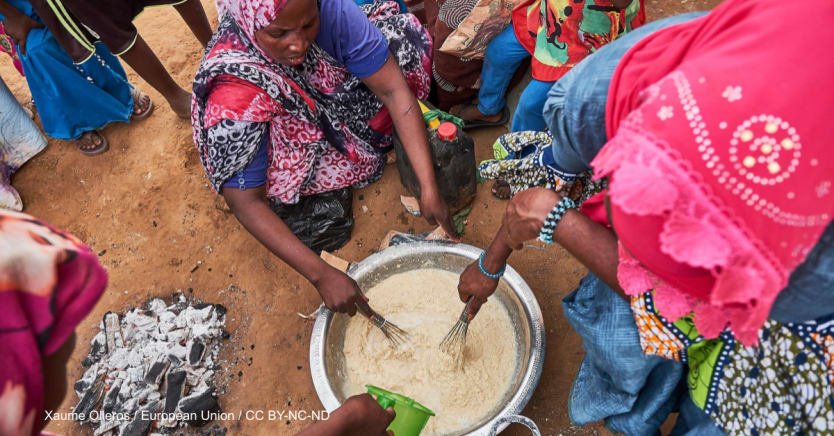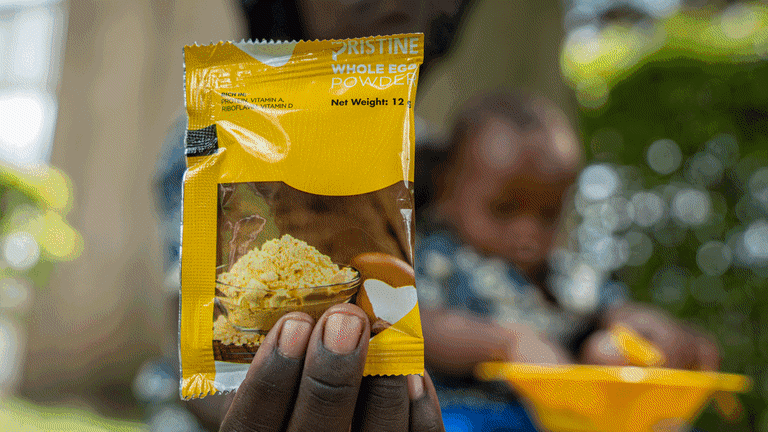
The COVID-19 pandemic threatens to derail much of the progress made in recent decades toward ending child malnutrition.
William Moore, CEO of the Eleanor Crook Foundation, is hopeful that despite the challenge, the year ahead offers a unique opportunity for the world to not only recover but also set out to finally solve this most persistent of human challenges.
Even pre-pandemic, malnutrition was the leading cause of death for children globally, with just over 3 million under the age of 5 dying from malnutrition-related causes every year — a life lost every 11 seconds — mostly in low- and middle-income countries. One in four children globally suffer irreversible physical and cognitive impacts.
Despite this, less than 1% of official development assistance is currently spent on nutrition interventions. Moore sat down with Devex to discuss why he’s optimistic this will change.
This conversation has been edited for length and clarity.
How much progress have we made to-date on hunger and malnutrition?
Over the past 30 years, humanity has halved global hunger and malnutrition. This was mostly a byproduct of rapid economic growth and expansion of basic health services to many of the world’s poorest.
UN food security committee adopts guidelines on food systems and nutrition
The document is a nonbinding tool for governments, U.N. agencies, civil society, the private sector, and financial institutions to provide guidance, policies, and interventions for addressing malnutrition through a holistic food systems perspective.
The progress made should be applauded, but it is still insufficient and uneven. A huge proportion of people who have been lifted out of malnutrition and poverty are in India and China. In other countries, hunger and malnutrition actually increased in recent years, partly due to the destabilizing effects of climate change and conflict.
In many countries where we’ve seen national-level improvements in nutrition, pockets of immense food insecurity and malnutrition persist, usually among society’s most vulnerable. So we have gotten closer to ending malnutrition, but there is much more to do. Lack of financing and prioritization by health and development actors are among the most significant barriers.
Though ready-to-scale, life-saving nutrition interventions have existed for years, they have not been integrated into health systems, and are still not reaching most people who need them. These are simple products and services: prenatal vitamins, breastfeeding support, vitamin A supplementation, and emergency therapeutic food for wasted children. This “Power 4” package has been identified by Johns Hopkins University — and recognized by The Lancet and the World Bank — to be among the most lifesaving nutrition interventions. These can be scaled up alongside routine health services and together have an amazing multiplier effect.
For food systems, large-scale fortification of staple foods with essential vitamins and micronutrients — including iron, folate, and vitamin A — is also a proven, cost-effective way to reach more people with vital nutrients.
What impact has the COVID-19 pandemic had on childhood malnutrition and wasting?
Many gains made in child nutrition over recent decades were lost overnight in spring 2020, as community health systems went dark and households lost significant income. Local clinics closed and many health workers were not even allowed to leave their homes. Families were left without access to health care or social protection. As is almost always the case, women and children suffered the most.
In many low- and middle-income countries, the knock-on effects of the pandemic — disruptions in food systems, health systems, and economies — will be more devastating than the virus itself. The danger is a lost generation of kids who will have had zero touchpoints with health systems during those critical first 1,000 days between conception and their second birthday. We’re going to see mothers who didn’t receive breastfeeding support, and kids who don’t receive vitamin A supplements and without access to therapeutic food if they are suffering from wasting. Millions will suffer permanent impacts to their physical health and cognitive development.
Against this backdrop, what commitments are you hoping to see at December’s Nutrition for Growth summit?
Donors are feeling pressure to spend money domestically, and international development assistance is being cut by a number of donors. But, I think it’s particularly important that the United States and the United Kingdom — historically the world’s largest donors for global nutrition — make commitments to keep global malnutrition on a downward trajectory. If these leading donors on malnutrition fail to recommit, it’s hard to envision a scenario where COVID-related increases in malnutrition do not become permanent.
What can the administration of U.S President Joe Biden do to tackle this growing crisis? How can we regain momentum of past decades to ensure progress in ending malnutrition?
In 2020, the U.S. invested $150 million in tackling malnutrition globally — meaning it dedicated only 0.3% of its total aid budget to an issue that contributes to half of all childhood deaths. We know U.S. financial and political leadership can make all the difference: last year, the U.S. spent $8.2 billion on tackling AIDS, malaria, and tuberculosis — an investment the government makes knowing it can change the trajectory of global health and development.
With an investment of $580 million per year over the next five years to scale high-impact nutrition interventions through food and health systems, child mortality globally could be reduced by 10%.
President Biden has a track record of impactful leadership in the fight against hunger and malnutrition. In 2018, he described nutrition as the foundation upon which every child’s future is built, and has spoken at length about what malnutrition does to children’s bodies, limiting their potential. And of course, as vice president he helped launch Feed the Future, one of [former] President Obama’s signature international development initiatives to tackle food insecurity.
We are hopeful that the new administration will recognize nutrition as an area where additional investment can go a long way in helping the world not only recover from the COVID-19 pandemic, but also build back better.
What else gives you hope in the global fight against malnutrition?
What gives me hope is that this is a problem we could solve in just a few short years if we could only muster the will. Let’s end malnutrition, if for no other reason than to prove we can. That we can still drive progress, ease suffering, and ultimately make the world a better place. As two of the world’s longstanding development superpowers, I am hopeful that the U.S. and the U.K. will continue to lead the way.
Take a closer look at what it takes to improve child nutrition outcomes. You can join the conversation using the hashtag #NextGenNutrition.








